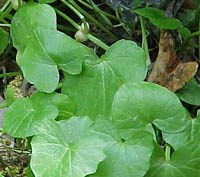
NPS Photo There are a number of introduced, nonnative plant species that threaten many of the native wildflowers, trees, and shrubs at Wolf Trap Naitonal Park for the Performing Arts. Japanese honeysuckle (Lonicera japonica) vines are strangling some smaller trees, and the low-growing multiflora rose (Rosa multiflora) is crowding out native shrubs. In the late 1990s, the National Park Service developed Exotic Plant Management Teams to locate and control exotic plants, and assist in restoring these sites to their native ecosystems. The most aggressive invader at Wolf Trap National Park for the Performing Arts is the lesser celandine plant (Ranunculus ficaria). This small European plant forms clumps of attractive green leaves and yellow flowers along the stream and in wetter areas, blooming early in the spring. Although beautiful, celandine forms thick, impenetrable mats that choke out native wildflowers. The park has begun an aggressive campaign to control lesser celandine. Other exotic species in the park that may need controls in the future are Japanese stiltgrass (Microstegium vimineum), garlic mustard (Alliaria petiolata), Japanese barberry (Berberis thunbergii), and beefsteakplant (Perilla frutesceus). |
Last updated: January 2, 2020
